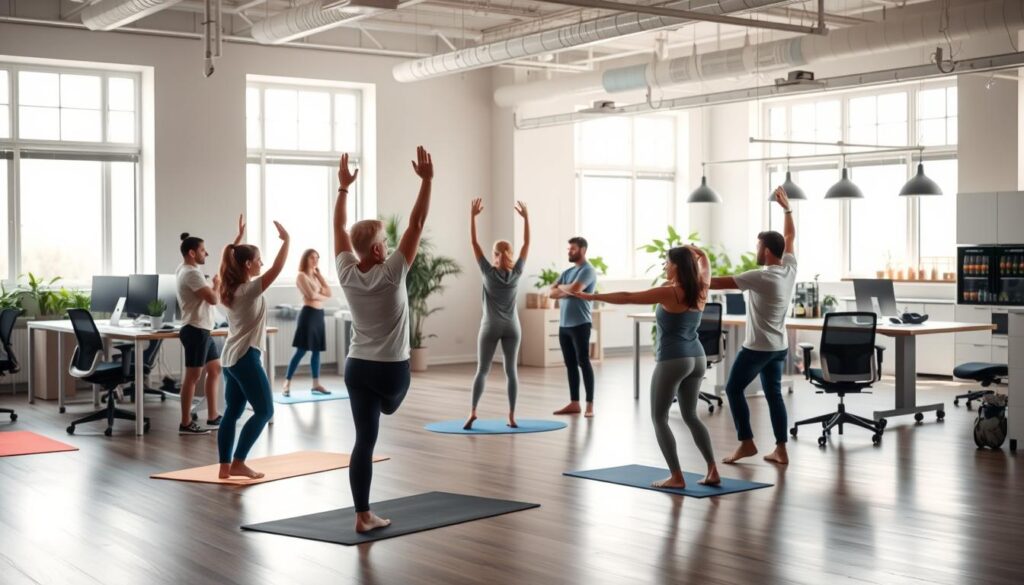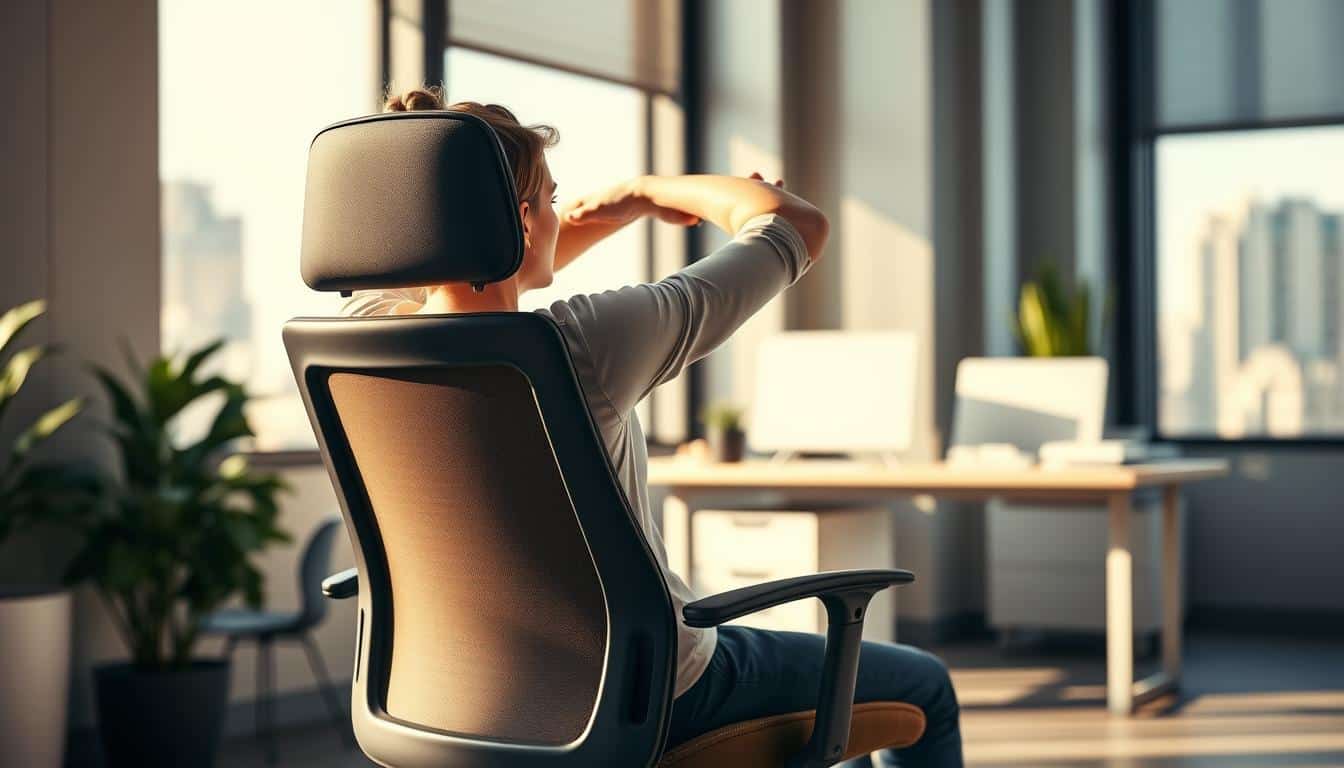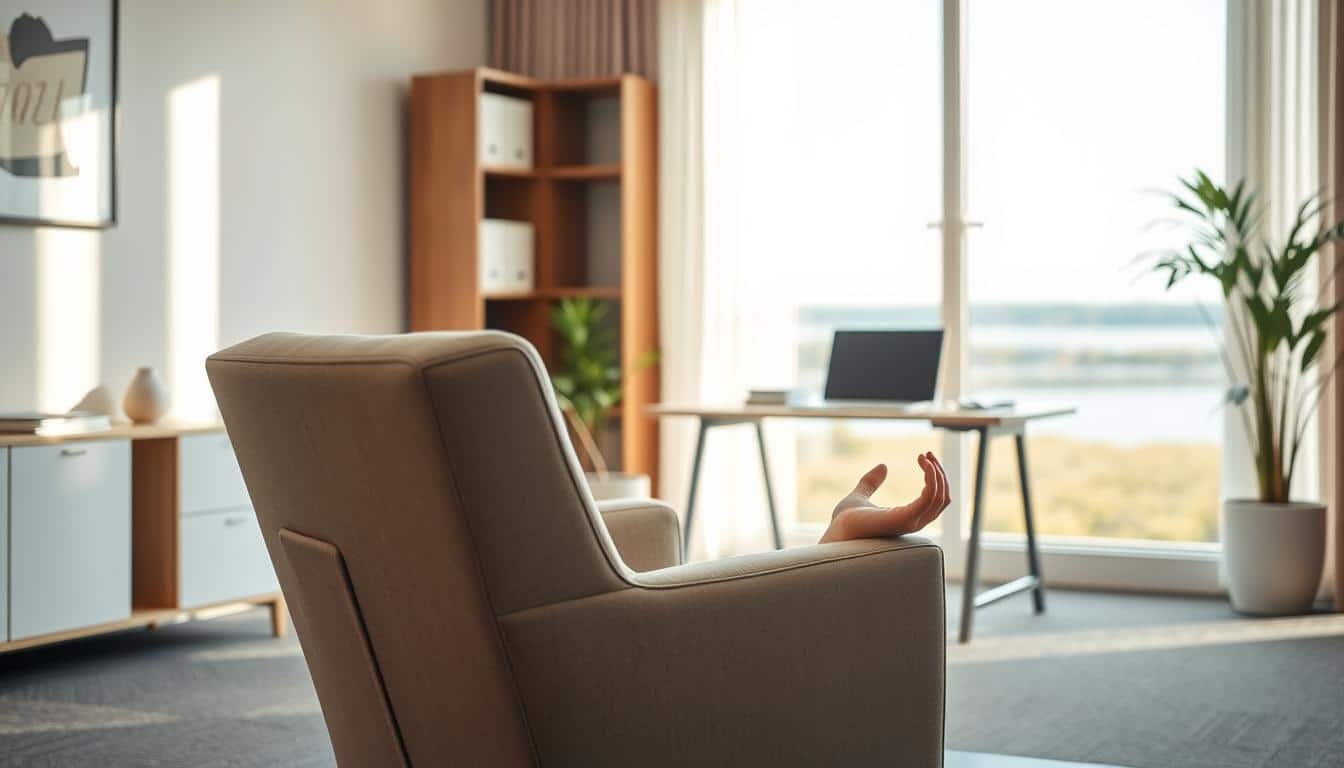With the quick pace of today’s work life, desk stretches for flexibility are key for wellness at work. People working at desks often feel stiff and uncomfortable from sitting too much. This can stop them from doing their best work. By doing simple stretches at your desk, like chair stretches, you can feel better and work better.
Studies prove these easy moves can up blood flow to your joints and muscles. They give you a break that makes your mind sharper and eyes less tired. In the end, desk stretches are not just good for your body but they also boost your work performance.
The Importance of Stretching at Your Desk
Stretching at your desk is very important for people who sit a lot. Sitting too long can make your muscles stiff and limit movement. Doing regular stretches keeps blood flowing and muscles relaxed, which is good for your health at work.
Stretching helps make you more flexible and prevents getting hurt. It also keeps joints healthy. Brief breaks for stretching can make you feel more awake and think clearer. People who stretch at work are often more productive.
Additionally, stretching is great for your posture. It makes muscles that hold you up stronger, reducing back problems from bad sitting habits. It also lowers stress and makes you happier, which can make you enjoy your job more.
Doing simple stretches at your desk, like lifting your legs or tightening your stomach, helps fight muscle stiffness. Also, walking to talk to someone instead of emailing can keep you active without losing work time.
Understanding the Risks of Sedentary Work
Sitting for long hours at work brings about health challenges. Workers face dangers like musculoskeletal disorders. These can cause chronic pain in the back, neck, and shoulders.
In the U.S., adults often sit for about 9 hours each day. This habit increases the risk of health problems such as obesity and type 2 diabetes. It’s also linked to certain cancers and a higher chance of dying early. For example, bus drivers who sit a lot have twice the risk of having a heart attack than those who move more.
Being inactive doesn’t just harm physical health; it affects mental well-being too. A study showed that office workers who started stretching for 12 weeks felt better in many ways. They had more energy, less pain, and improved mental health. This shows why it’s essential to tackle the issues of sitting too much.
To fight the harmful effects of sitting, we need to stand and move more at work. Even small steps, like stretching at your desk or having meetings on the go, can make a big difference. These changes can ease the discomfort of sitting all day and reduce health risks.
Benefits of Desk Stretches for Flexibility
Adding desk stretches to your day offers many benefits. Regular stretches can make your workday better by boosting your productivity and energy. They do more than just ease discomfort; they make your workplace healthier.
Increased Blood Flow and Energy
Desk stretches help improve blood flow. This is key for getting oxygen and nutrients to your muscles. It fights off tiredness and is great for beating the after-lunch slump. You’ll find yourself with more energy, staying sharp all day.
Enhanced Posture and Reduced Pain
Stretching at your desk is great for your posture and easing pain from sitting too long. Changing how you sit every 30 to 60 minutes is advised to avoid the downsides of sitting all day. Stretching right helps keep your spine aligned and eases tension in your neck, shoulders, and back. This means better posture and less discomfort after long hours at your desk.
Improvement in Focus and Productivity
Stretching during your workday can help you focus and get more done. Studies show that taking short breaks for some movement can increase your work performance. By fitting these stretches into your day, you refresh your body and mind. This leads to a more productive work environment and better results.
Essential Desk Stretches for Flexibility
Adding essential desk stretches to your day is crucial for staying flexible and feeling good. Doing simple stretches can ease pain and make you move better. This makes them great to include in your day. Here are some easy stretches you can do right at your desk.
Overhead Reach for Shoulder Relief
The overhead reach does wonders for your shoulders. Stretching your arms up eases shoulder tension. It’s great for relaxing and moving better, especially after sitting for a while.
Seated Spinal Twist for Torso Mobility
The seated spinal twist is fantastic for your torso. It makes your spine flexible and helps get rid of stress from sitting too long. Doing this stretch often might help you sit straighter and hurt less.
Hip Flexor Stretch for Lower Back Comfort
The hip flexor stretch helps avoid lower back pain. It eases hip tension, which helps your lower back feel better. If you sit a lot, this stretch is great to try.
Quick Office Moves: Incorporating Stretching into Your Day
More than 80% of American jobs are desk jobs. This makes it important to mix in quick stretches during work. To keep healthy and productive, set a timer for stretching breaks every hour. This will help make active work habits stick and keep exercise important all day.
It’s key to use workplace wellness ideas. Adding mini-exercise challenges in meetings is a great way to move a little and help team members bond. These exercises don’t take much time, but they boost happiness and work performance.
Stretching your arms, torso, legs, and neck can ease the pain from sitting too long. Try crossing one ankle over your knee and lean forward gently while seated for a hip stretch. Twisting your torso to the back of the chair while sitting can ease spine pain and help blood flow.
Stretches that help your shoulders and chest can reduce upper body stress. Also, stretching your wrists and forearms can prevent pain from typing or other repetitive work. These stretches can improve your posture and lower the chance of muscle and joint pain. Stretching regularly at work can create a healthier and more efficient office.
Top Desk Stretches for Flexibility
Adding good stretches to your office day makes it more comfortable and helps you move better. Top desk stretches are key for staying well and easing the pains of sitting too long. Here are some great moves for office workers to tackle common sore spots.
Triceps Stretch for Arm Comfort
This move is great for easing arm tightness from repeating the same actions. Lift an arm up, bend it at the elbow, and use the other hand to gently pull the elbow. Stay in this pose for 15 to 30 seconds. It’s important for making the upper arms more flexible.
Forward Bend for Lower Back Relief
The forward bend is great for lessening lower back tension. Stand up, bend forward from your hips while keeping a small bend in your knees. Let your head and arms droop to the ground. Hold for 20 to 30 seconds. Doing stretches for the lower back like this one keeps your spine feeling good.
Neck Stretches to Combat Tech Neck
Neck stretches tackle the pain from looking at screens too much. Sit up straight, then lean your head to one side and lightly pull down for a deeper stretch. Do this for 15 to 30 seconds on each side. It helps lessen the tension from computer use.
Strategies to Remain Active While Working
Staying active at work is key for your well-being. Using active strategies at work is great for your health. Try a standing desk to help with posture and keep moving.
Doing stretches often is another way to stay moving. This stops you from sitting too much.
Taking brief breaks is very important. Every 20-30 minutes, stretch or stand to boost your focus and energy. Try simple desk exercises like the Rubber Neck or Seated Spinal Twist. They help ease stiffness and make your spine more flexible.
Do Chair Squats or Desk Push-Ups to build strength and keep flexible. These actions can keep you active during the workday.
Try walking meetings to mix work and movement. It can change the feel of your workplace. Having yoga sessions at work brings in a movement culture. It makes being active fun.
A lively, active team is the result of ongoing effort. This benefits everyone’s physical and mental health.
Cautions While Performing Desk Stretches
Doing desk stretches can really help you feel more flexible and comfy during work. But it’s key to stretch safely to avoid any harm. It’s super important to know how your body feels while you stretch. If a stretch feels wrong, it’s okay to change how you do it or to stop completely. This way, you keep your movements comfortable.
Listening to Your Body
While stretching at your desk, pay close attention to what your body tells you. Make sure to stretch only as far as feels okay. If it starts to hurt, change the stretch or just stop. Here are a few things to keep in mind:
- Only hold stretches that feel okay and don’t push too hard.
- Skip movements that make you uncomfortable or cause pain.
- Keep your back straight and core tight to avoid hurting yourself.
- If your chair doesn’t support your back well, use something like a rolled-up jacket for help.
Avoiding Overexertion
Trying too hard when you stretch can cause strain and maybe even injury. Following the right tips for stretching can really help. To stay safe, remember these suggestions:
- Start your stretches gently, especially if your muscles are cold.
- If a stretch makes you feel stiff or hurts, stop right away.
- Try to stretch every 60-90 minutes to keep flexible.
- If pain doesn’t go away, get advice from a pro on what exercises are best.
Integrating Stretching into Office Culture
To build a better office culture, it’s smart to encourage stretching at work. Adding regular stretching to daily work can make both body and mind feel better. This can make the office a place where wellness is part of what everyone does.
Starting a health program that includes stretching helps with good posture and lowers injury risks. Easy exercises like neck tilts and shoulder rolls don’t need special gear. These exercises help with blood flow and ease stress, making everyone more productive.
When companies support stretching, workers feel less tired and think clearer. Such programs boost overall health and make the workplace better. Making stretching a key part of health efforts shows a strong promise to care for employees.

Conclusion
In short, adding simple stretches to your workday is key for more health and flexibility at work. Stretching helps reduce pain from sitting too long and makes you more flexible. It also makes a healthy work environment. Research shows that these stretches help more with pain relief than just ergonomic changes.
Regular stretches can cut down on pain, especially in your neck, shoulders, and lower back. They boost your blood flow, ease muscle tension, and give you more energy. This leads to better focus and more work done. Plus, you don’t need any special gear to do these stretches, so anyone can try them.
So, it’s really important to include stretching at work. Companies that do this will not only have happier workers but also better results and job happiness. This shows how vital movement is in today’s office life.



